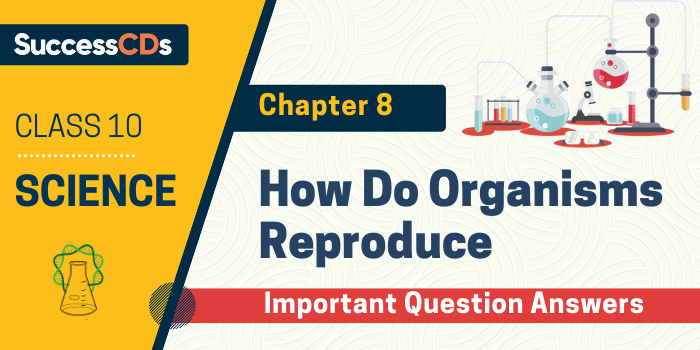
CBSE Class 10 Science Chapter 8 How Do Organisms Reproduce Important Questions Answers
How Do Organisms Reproduce Important Questions – Here are the important questions for CBSE Class 10 Science Chapter 8 How Do Organisms Reproduce. The important questions we have compiled will help the students to brush up on their knowledge about the subject. Students can practice Class 10 Science important questions to understand the subject better and improve their performance in the board exam. The solutions provided here will also give students an idea about how to write the answers. Take Free Online MCQ Test for Class 10
Class 10 Science How do organisms Reproduce MCQs (1 Marks)
Q1. Tubectomy is carried out by blocking the
(a) Oviduct
(b) Uterus
(c) Cervix
(d) Vagina
Answer – (a) Oviduct
Q2. Fertilization occurs in the human female when the sperms and ovum reach simultaneously at
(a) Fallopian tube
(b) Uterus
(c) Vagina
(d) Cervix
Answer – (a) Fallopian tube
Q3. Which of the following is the correct sequence of events of sexual reproduction in a flower?
(a) Pollination, fertilisation, seedling, embryo
(b) Seedling, embryo, fertilisation, pollination
(c) Pollination, fertilization, embryo, seedling
(d) Embryo, seedling, pollination, fertilization
Answer – (c) Pollination, fertilization, embryo, seedling
Q4. Offspring formed as a result of sexual reproduction exhibit more variations because
(a) Sexual reproduction is a lengthy process
(b) Genetic material comes from two parents of the same species
(c) Genetic material comes from two parents of different species
(d) Genetic material comes from many parents
Answer – (b) Genetic material comes from two parents of the same species
Q5. Bryophyllum can be propagated vegetatively by the
(a) stem
(b) leaf
(c) root
(d) flower
Answer – (b) leaf
See Video of How Do Organisms Reproduce
How do Organisms Reproduce Related Links
| How do Organism Reproduce Explanation Notes | How do Organism Reproduce MCQs |
| How do Organism Reproduce Video Explanation | How do Organism Reproduce MCQs Video |
Class 10 Science How do organisms Reproduce Short Answer Type
Q1. Name the body part where fertilization occurs in the human female.
Answer – Fallopian tube.
Q2. List two functions performed by the testis in human beings.
Answer – Two Functions of Testes are:
- To produce the male sex cells (gametes) called sperms.
- To secrete the male sex hormone called testosterone which is responsible for secondary sexual changes in males.
Q3. Name two simple organisms having the ability of regeneration.
Answer – Two simple organisms having the ability of regeneration are Planaria and Hydra.
Q4. Name the part of Bryophyllum where the buds are produced for vegetative propagation.
Answer – The leaves produce buds in Bryophyllum which are used for vegetative propagation.
Q5. What are those organisms called which bear both the sex organs in the same individual? Give one example of such an organism.
Answer – Organisms having both the sex organs in the same individual are called Hermaphrodite. E.g., Earthworm
Q6. List two functions of the ovary of the human female reproductive system.
Answer – Two Functions of Ovary:
- To produce female gamete ovum
- To secrete female hormones estrogen & progesterone.
Class 10 Science How do organisms Reproduce Short Answer Type I
Q1. How does an embryo get nourishment inside the mother’s body?
Answer – After implantation, a disc-like special tissue develops between the uterus wall and the embryo called placenta. The exchange of nutrients, oxygen, and waste products between the embryo and the mother takes place through the placenta.
Q2. What is meant by asexual reproduction? List its any two different forms.
Answer – Asexual reproduction. The production of a new organism from a single parent without the involvement of sex cells is called asexual reproduction.
Different Forms:
- Fission
- Budding.
Q3. Mention the two functions of the human testis.
Answer – Functions of Human Testis:
- Testes make male sex hormones called testosterone.
- Testes produce male sex gametes, i.e., sperms.
Q4. (a) How do Leishmania and Plasmodium reproduce?
(b) State one difference in their mode of reproduction.
Answer – (a) Leishmania and Plasmodium reproduce by fission (asexual mode of reproduction)
(b) (i) Leishmania reproduce by binary fission in which the parent organism splits to form two new organisms.
(ii) Plasmodium reproduces by multiple fission in which the parent organism splits to form many new organisms at the same time.
Important Videos Links
Class 10 Science How do organisms Reproduce Short Answer Type II
Q 1. (a) List two sexually transmitted diseases in each of the following cases:
(i) Bacterial infections
(ii) Viral infections
(b) How may the spread of such diseases be prevented?
Answer –
(a) Sexually Transmitted Diseases:
Bacterial infections. Gonorrhoea, Syphilis Viral infections. Warts, AIDS (Acquired Immuno Deficiency Syndrome)
(b) Barrier method of contraception provides protection against STDs like AIDS, Syphilis etc.
Observing hygienic conditions.
Q 2. What does HIV stand for? Is AIDS an infectious disease? List any four modes of spreading AIDS.
Answer –
HIV. Human Immunodeficiency Virus
This virus causes AIDS which is an infectious disease.
Modes of Spreading AIDS:
- The AIDS disease usually spreads through unprotected sexual contact with an infected person carrying the AIDS virus.
- The AIDS disease also spreads through the transfusion of blood contaminated with the AIDS virus.
- The AIDS disease also spreads through the use of infected needles for injections.
- An AIDS-infected mother can transmit the virus to her child during pregnancy or during birth.
Q3. What are sexually transmitted diseases? Write two examples each of sexually transmitted diseases caused by (i) virus, (ii) bacteria. Explain how the transmission of such diseases is prevented?
Answer – Diseases which are transmitted from an infected person to a healthy person due to sexual contract are called Sexually Transmitted Diseases (STD).
Sexually transmitted diseases caused by
(i) Virus:
AIDS (Acquired Immuno Deficiency Syndrome)
Genital warts
(ii) Bacteria:
Gonorrhoea
Syphilis
Transmission of such diseases can be prevented in the following ways:
- Screening tests for blood donors
- Mutually faithful monogamous relationships
- Educating people in high-risk groups
- Using condoms etc.
Q4. Name the following:
(i) threadlike non-reproductive structures present in Rhizopus.
(ii) ‘blobs’ that develop at the tips of the non-reproductive threads in Rhizopus.
(b) Explain the structure and the function of the structures released from the ‘blobs’ in Rhizopus
Answer – (a) (i) Threadlike non-reproductive structures present in Rhizopus is hyphae.
(ii) Blob like structure at the tip of hyphae is sporangia.
(b) Threadlike non-reproductive parts develop on the substrate (like bread) called hyphae. At the tip of the hyphae, tiny blob-like structures develop called sporangia which contain spores. These spores can develop into new Rhizopus individuals. The spores are covered by thick walls that protect them until they come into contact with another moist bread and can begin to
grow.
Q5. (a) Write the names of those parts of a flower that serve the same function as the following do in the animals:
(i) testis (ii) sperm (iii) ovary (iv) egg
(b) State the function of flowers in the flowering plants.
Answer –
(a) (i) testis – anther
(ii) sperms – pollen grains
(iii) ovary – ovary
(iv) egg – egg or ovum
(b) The function of flower in flowering plants is to assist in sexual reproduction, i.e., to make male and female gametes and to ensure that fertilization will take place to make new seeds for the reproduction in plants.
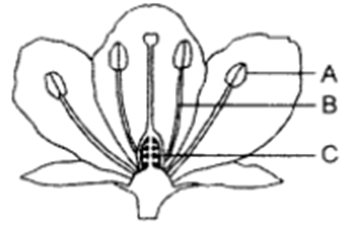
Answer – Name the parts A, B, and C shown in the following diagram and state one function of each.
A → Anther. It produces pollen grains which are the male gametes.
B → Style. It provides the path through which the pollen tube grows and reaches the ovary.
C → Ovary. It contains ovules and each ovule has an egg cell/female gamete. It develops into fruit after fertilization.
Q6. (a) List two reasons for the appearance of variations among the progeny formed by sexual reproduction.’
(b) (i) Name the part marked ‘A’ in the diagram.
(ii) How does ‘A’ reach part ‘B”
(iii) State the importance of part ‘C’.
(iv) What happens to the part marked ‘D’ after fertilisation is over?

Answer – (a) The appearance of variations among the progeny formed by sexual reproduction is due to the following reasons:
(i) Sexual reproduction takes place by the combination of two germ cells produced by two different individuals. The fusion of the male and female gametes.
(ii) Each time zygote is formed by the new combination of variants.
(b) (i) A ⇒ Pollen grains
(ii) Pollen grains, i.e., ‘A’ reach part ‘B’, i.e., the stigma of the carpel by the process of pollination. Pollination is carried out by insects (like bees, butterflies, etc.), birds, wind, water, etc.
(iii) ‘C’ ⇒ Pollen tube
The pollen tube grows downward through the style towards the female gamete in the ovary.
Pollen tube helps the male gamete reach the egg or ovule (female gamete).
(iv) ‘D’ ⇒ Fertilised egg or Zygote
The fertilized egg (or zygote) divides several times to form an embryo within the ovule.
Q7. (a) Draw a diagram of the longitudinal section of a flower and label on it sepal, petal, ovary and stigma.
(b) Write the names of male and female reproductive parts of a flower.’
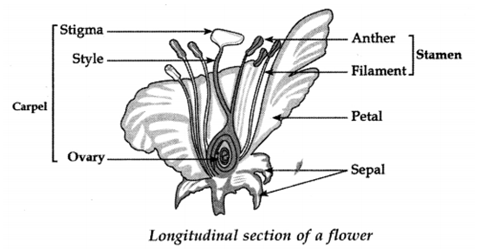
Answer – (a) in the diagram
(b) Male reproductive part- Stamen.
Female reproductive part- Carpel.
Q8. Draw a diagram of the human female reproductive system and label the part
(i) that produces eggs.
(ii) where the fusion of egg and sperm takes place.
(iii) where zygote is implanted.
What happens to a human egg when it is not fertilised?
Answer – Human female reproductive system:
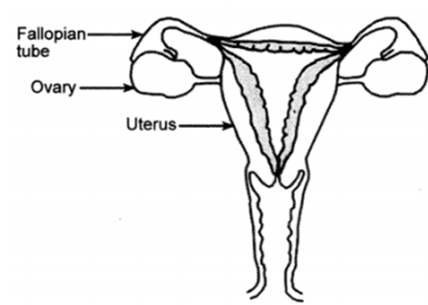
(i) the part that produces eggs – Ovary
(ii) where the fusion of egg and sperm takes place – Fallopian tube
(iii) where the zygote is implanted – Uterus
When a human egg is not fertilised then the thick and soft inner lining of the uterus is no longer needed and hence it breaks down in the form of vaginal bleeding known as menstruation. Unfertilized egg also passes out along with menstrual bleeding.
Draw a Sectional view of the Human male Reproductive System and write about its part:
It consists of Testis, scrotum, epididymis, Vas deferens or sperm duct, seminal vesicles, prostate gland, penis.
1. Testes: They are oval-shaped organs, lie in the abdominal cavity. There are 2 testes in males, make male sex cells called sperm and male sex hormone called testosterone.
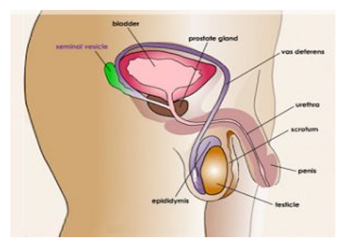
2. Scrotum: Testes lie in a small muscular pouch outside the abdominal cavity because sperm formation requires a lower temperature than the temperature inside the body.
3. Epididymis: The sperms formed in testes come out and go into a coiled tube called the epididymis.
4. Vas Deferens: From epididymis sperms are carried by a long tube that joins another tube called the urethra coming from the bladder.
5. The glands seminal vesicles and prostate gland add their secretion to sperms so that sperms become liquid. Semen contains liquid and sperm.
6. Penis: It passes the sperm from the man’s body into the vagina of the female’s body during mating.